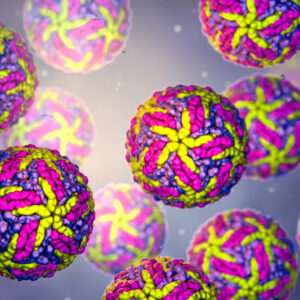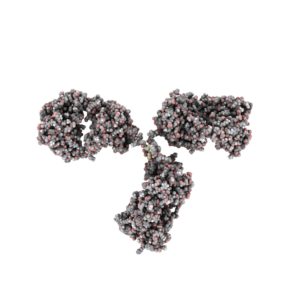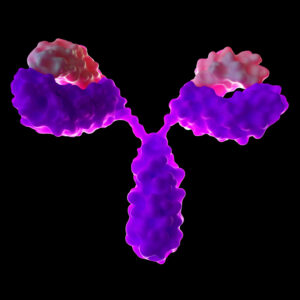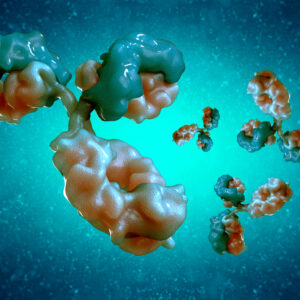Rhinovirus
Rhinoviruses (RV) belong to the genus Enterovirus in the family Picornavirida and are the primary aetiological agent of the common cold. Generally, the associated infection is mild and self-limiting, but it can also be associated with more severe disease such as bronchiolitis in infants and pneumonia in the immunocompromised. Allergy and asthma are also major risk factors for more frequent and severe RV-related illnesses.
Rhinovirus Background
Rhinoviruses were isolated in 1953 by Winston Price at Johns Hopkins University, when he took nasal passage samples from a cluster of nurses who had developed a mild respiratory illness. The three species of rhinovirus (A, B, and C) include around 160 recognized types of human rhinovirus that differ according to their surface proteins (serotypes). They are lytic in nature and are among the smallest viruses, with diameters of about 30nm. Rhinoviruses have a single-stranded positive sense RNA genome (7200 and 8500 nt). At the 5′ end of the genome is a virus-encoded protein and a 3′ poly-A tail. As for all picornaviruses, structural proteins are encoded in the 5′ region of the genome and non-structural at the 3′ end. The viral proteins are translated as a single, long polypeptide, which is cleaved into the structural and non-structural viral proteins. The viral capsid contains four viral proteins, VP1, VP2, VP3 and VP4. VP1, VP2, and VP3 form the major part of the protein capsid. The much smaller VP4 protein has a more extended structure, and lies at the interface between the capsid and the RNA genome. There are 60 copies of each of these proteins assembled as an icosahedron and viral particles are not enveloped (Ortega et al., 2020).
There are two modes of transmission: via aerosols of respiratory droplets and from fomites (contaminated surfaces), including direct person-to-person contact. Rhinoviruses are spread worldwide and are the primary cause of the common cold. Symptoms include sore throat, runny nose, nasal congestion, sneezing and cough; sometimes accompanied by muscle aches, fatigue, malaise, headache, muscle weakness, or loss of appetite. Those most affected by rhinoviruses are infants, the elderly, and immunocompromised people (Michi et al., 2020). The primary route of entry for human rhinoviruses is the upper respiratory tract (mouth and nose), where they preferentially grow at 32°C (89°F) due to the respiratory airflow being in continual contact with the (colder) extra somatic environment. Rhinovirus A and B bind to the respiratory epithelial cell receptor ICAM-1 (Inter-Cellular Adhesion Molecule 1), also known as CD54 (Cluster of Differentiation 54). Some subgroups under A and B use the LDL receptor instead. Rhinovirus C binds cadherin-related family member 3 (CDHR3) to mediate cellular entry. As the virus replicates and spreads, infected cells release chemokines and cytokines which in turn activate inflammatory mediators and consequently, cell lysis occurs at the upper respiratory epithelium (Ganjian et al., 2020).
There are no vaccines available as there is little-to-no cross-protection between serotypes and at least 99 serotypes of human rhinoviruses affecting humans have been sequenced. Antibodies provide the major defence against infection with the epitopes lying on the exterior regions of VP1-VP3. However, the VP1 and VP4 proteins have been shown it to be highly conserved among many serotypes which may suggest potential for a future pan-serotype human rhinovirus vaccine (Katpally et al., 2009).
References
- Ganjian H, Rajput C, Elzoheiry M, Sajjan U. Rhinovirus and Innate Immune Function of Airway Epithelium. Front Cell Infect Microbiol. 2020 Jun 19;10:277.
- Katpally U, Fu TM, Freed DC, Casimiro DR, Smith TJ. Antibodies to the buried N terminus of rhinovirus VP4 exhibit cross-serotypic neutralization. J Virol. 2009 Jul;83(14):7040-8.
- Michi AN, Love ME, Proud D. Rhinovirus-Induced Modulation of Epithelial Phenotype: Role in Asthma. Viruses. 2020 Nov 19;12(11):1328.
Ortega H, Nickle D, Carter L. Rhinovirus and asthma: Challenges and opportunities. Rev Med Virol. 2020 Nov 20:e2193.
Rhinovirus antigens
We are pleased to provide a Rhinovirus lysate manufactured in MRC-5 / HeLa cells using sucrose density gradient ultracentrifugation, disrupted in the presence of detergent and heat inactivated, for use in assay development and other research applications.
Rhinovirus antibodies
We offer three Rhinovirus antibodies against VP3 which are suitable for use in laboratory research and vaccine development.
Questions?
Check out our FAQ section for answers to the most frequently asked questions about our website and company.




